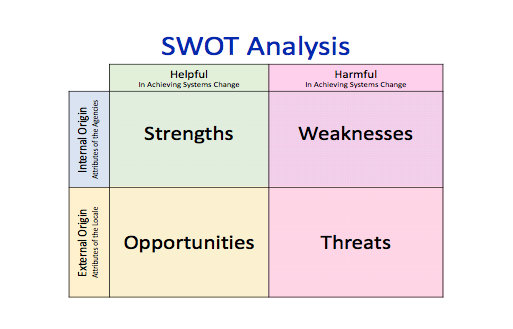Step Two: Analyzing Internal and External Barriers and Resources
A strategic plan is based on a clear, defined starting point. Root cause derived from Step One provides that type of starting point. Now, the Team needs to develop a shared understanding of the factors and dynamics that are related to the root cause problem statement(s). Examining the barriers and the potential resources for addressing each of the problems leads the Team to identify achievable goals and strategies for their plan.

A tool useful to examine factors related to the root cause statements is the SWOT process. SWOT is an acronym for Strengths, Weaknesses, Opportunities and Threats. SWOT is a structured small group process to identify the internal and external factors that are helpful and harmful to addressing the problems at hand. The SWOT Analysis graphic depicts the inter-relationships among the four categories of factors encompassed in a SWOT analysis process.
The SWOT process is especially useful for Multi-Agency Teams. The process provides an agency neutral framework for identifying the factors that are a common priority to the multiple agencies that will be involved in implementing the strategic plan. It is necessary for the Team to settle on that common ground since, separately, each agency has its singular priorities, requirements, accountability measures, procedures, etc. A collaboratively developed and implemented strategic plan requires that ‘common ground’, common concerns, and common priorities are identified, doable and acceptable to all agencies concerned.
The SWOT analysis offers Teams a systematic process for reflecting on the internal and external factors that exist within and across the agencies represented on the Multi-Agency Team. The SWOT process is indispensable to informing the direction of the next steps in designing the Team’s strategic plan.
SWOT may be a familiar process that you have either participated in or facilitated. Or SWOT may be a new process to you. Whatever the level of experience with SWOT, it is important to start by defining the terms as they are used in this guide and included in the graphic SWOT Analysis Process: Definitions of and Relationships Among the Factors.
Origins and Uses of SWOT Process
SWOT Analysis originated in business world. Recently, it has been utilized by human service organizations as an effective tool to engage in social and cultural change processes. Some ways it has been used by schools, social service and community organizations is to:
- Organize information for engaging multiple stakeholders
- Provide insight into barriers that may be present while engaging in social change
- Identify strengths available that can be activated to counteract barriers
- Explore new solutions to long standing problems by engaging with atypical partners in the community
- Decide on the direction of strategies that will be effective, successful, and afford least resistance
- Reveal possibilities and limitations for change
- Provide a record of brainstorming and discussion for communication to a larger group of stakeholders
- Present issues and ideas in a coherent manner to gain support of agency leaders and key community supporters